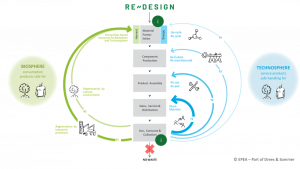Cradle to Cradle – Being good instead of less bad

The Cradle to Cradle design concept is an approach towards the circular economy introduced by Michael Braungart and William McDonough. It provides a framework for designing products whose materials flow safely in closed loops, in contrast to the linear economy’s take-make-waste model. The emphasis lies on maintaining inputs at their quality level to render the concept of waste obsolete.
Eco-effectiveness for a positive ecological footprint
Have you ever also had the feeling that sustainable management practices approach environmental and social problems in the wrong way? They often rely on reducing or minimizing waste, pollution, consumption, or the like. These eco-efficiency approaches focus on decreasing humanity’s negative footprint on planet Earth by, for example, achieving carbon neutrality.
Wherever we look in nature, we find effectiveness rather than efficiency. For example, a cherry tree produces thousands of blossoms each year to end up with only one or two successful seeds. However, this is not problematic because the “waste” is not harmful but a nutrient for soil and animals. Moreover, during this process, the cherry tree also cleans air and water.
This leads to the question of how we can transform our activities so that they are not only less bad or neutral but also a positive contribution to the planet? We need to address the problem at its root cause through eco-effectiveness.
The biological and the technical cycle – design with the lifecycle in mind
The Cradle to Cradle design concept proposes that products belong to one of two distinct cycles: the biological cycle and the technical cycle.
Consumer goods are likely to end up back in the environment, as shampoo, for example, enters the water system during use. Therefore, such products should adhere to the principles of the biological cycle and be composed of renewable materials such as wood, hemp, or cotton. They should be designed to impose no harm to the environment and possibly even make a positive contribution by containing seeds or important microorganisms instead of microplastics.
Within the technical cycle, material inputs are maintained as nutrients in industrial cycles. Consumer durable goods made from renewable or non-renewable resources such as glass, metal, and plastic should be designed for disassembly. Thus, valuable materials can be dismantled after use to be recycled in a way that preserves their quality or even improves it (upcycling).

But how? Step by step towards Cradle to Cradle product design
Now the holistic C2C vision may sound a bit intimidating. Therefore, there is a five-step evolutionary approach that guides the way to design safe and circular products in the sense of Cradle to Cradle:
1. Get “free of” known culprits
2. Follow informed personal preferences
3. Creating a “passive positive list”
4. Activate the positive list
5. Reinvent
Hence, the very first step is to ensure that the product does not contain harmful ingredients at the chemical level. They should be omitted or be replaced by “healthy” ingredients. The Cradle to Cradle Products Innovation Institute regularly updates the publicly available list of these “X-chemicals”, i.e., chemicals that must not be contained in products.
The second guideline is that we should not be intimidated by the limited access to the information we have. Instead, we should still do our best and think logically about what might be better and what might have more negative effects. Try to make the best decisions based on what you know.
Building upon this, the “passive positive list” can be created. This is a detailed overview of all ingredients in the product, including an evaluation of their impact on the social and ecological environment. In addition, the context must be considered. For example, how and where is the product going to be used?
In the fourth step, each input on the previously designed list is improved to the point where everything can flow as a nutrient in either the biological or the technical cycle. In the last step, true innovation takes place. Everything about the product should be questioned and framed in an innovative way to create a positive impact.
EPEA (the Environmental Protection Encouragement Agency) was founded in 1987 by Michael Braungart as a company that consults and assesses companies along this path. EPEA and Ethica Finland have recently started cooperating to offer local consultation on Cradle to Cradle design in Finland. Furthermore, Cradle to Cradle Certified™ was introduced to give companies the opportunity to obtain a controlled and globally recognized product certificate for their achievement.
So, let’s dream big and reach a point where Turku is an integrated part of Finland’s unique nature, not just neutral – but positively contributing to it!
For a more detailed introduction to this topic, please feel free to watch this YouTube Video, and contact me to discuss C2C!
Writer:
Alexa Bresan
Master Degree Student in International Business
Cologne, North Rhine-Westphalia, Germany
References:
This article is based on the book:
McDonough, W., & Braungart, M. (2010). Cradle to cradle: Remaking the way we make things. North point press.
Further sources used:
Interviews with experts on Cradle to Cradle, which are anonymized here
About us. EPEA. Retrieved December 24, 2020, from https://epea.com/en/about-us
Braungart, M., McDonough, W., & Bollinger, A. (2007). Cradle-to-cradle design: Creating healthy emissions–a strategy for eco-effective product and system design. Journal of Cleaner Production, 15(13–14), 1337–1348.
HOW TO GET YOUR PRODUCT CRADLE TO CRADLE CERTIFIEDTM. MBDC. Retrieved December 24, 2020, from https://mbdc.com/how-to-get-your-product-cradle-to-cradle-certified/
Iosif-Lazăr, L.-C. (2012). The evolution of the Cradle to Cradle model implementation within organizations.
Söderberg, S. (2012). A cradle to cradle study at klättermusen.
What is Cradle to Cradle CertifiedTM? – Get Certified—Cradle to Cradle Products Innovation Institute. (n.d.). Retrieved December 24, 2020, from https://www.c2ccertified.org/get-certified/product-certification
![]()
